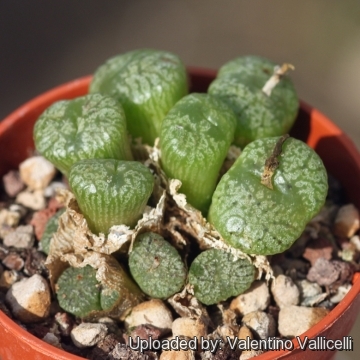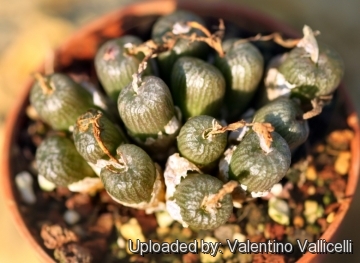
Conophytum ectypum subs. brownii Photo by: Valentino Vallicelli
Ratelpoort.
Origin and Habitat: Namaqualand, Northern Cape, SouthAfrica.
Habitat: It grows on outcrops or shaded crevices of quartz or granite.
Synonyms:
See all synonyms of Conophytum ectypum
Description: Conophytum ectypumSN|25993]]SN|25993]] subsp. brownii is a local or morphological form of the widely distributed and variable small species Conophytum ectypumSN|25993]]SN|25993]] that is more truncate at the top and has a few more lines upon it; there is no other difference.
Habit: It is very freely dividing species forming a tight mat-like cluster, but when allowed to form these clumps the individual bodies become progressively smaller.
Bodies (paired leaves): 85-10(-25) mm tall, 4-6(-10) mm in diameter, wholly fused (with a very small fissure), cylindrical or hatched-shaped (inverse-cone-shaped), with a truncate apex, rather soft, often keeled and enclosed in firm papery sheaths, greyish-green to purple, upper surface smooth, with a prominent line around the fissure, variably striate, striations not strongly reddened with ridges or raised dark green dots and sides of bodies not or only subtly sulcate.
Flowers: 8-10 mm in diameter opening in the morning. Highly variable in colour mostly pale pink to purple, rarely yellow or white. Anthers exerted.
Fruit: 4-6-locular hygrochastic capsules.
Subspecies, varieties, forms and cultivars of plants belonging to the Conophytum ectypum group
Bibliography: Major references and further lectures
1) Gordon D. Rowley “The illustrated encyclopedia of succulents” Crown Publishers, 01/Aug/1978
2) James Cullen, Sabina G. Knees, H. Suzanne Cubey “The European Garden Flora Flowering Plants: A Manual for the Identification of Plants Cultivated in Europe, Both Out-of-Doors” Cambridge University Press, 11/Aug./2011
3) Raimondo, D., von Staden, L., Foden, W., Victor, J.E., Helme, N.A., Turner, R.C., Kamundi, D.A. and Manyama, P.A. 2009. “Red List of South African Plants.” Strelitzia 25. South African National Biodiversity Institute, Pretoria.
4) Hammer, S. 1993. “The Genus Conophytum - A Conograph.” Succulent Plant Publications, Pretoria.
5) Hammer, S. 2002. “Dumpling and His Wife: New Views of the Genus Conophytum.” East Anglia Engraving Creative Colour Ltd, Norwich, England.
6) Ernst Van Jaarsveld, Ben-Erik Van Wyk, Gideon Smith “Succulents of South Africa: A Guide to the Regional Diversity” Tafelberg Publishers, Limited, 01/lug/2000
7) Heidrun E.K. Hartmann “Illustrated Handbook of Succulent Plants: Aizoaceae A-E” Springer, 2002
8) Werner Rauh “The Wonderful World of Succulents: Cultivation and Description of Selected Succulent Plants Other Than Cacti” Smithsonian Institution Press, 1984
9) Hermann Jacobsen “Lexicon of Succulent Plants” Littlehampton Book Services Ltd. 1974
 Conophytum ectypum subs. brownii Photo by: Valentino Vallicelli
Conophytum ectypum subs. brownii Photo by: Valentino Vallicelli Conophytum ectypum subs. brownii Photo by: Valentino Vallicelli
Conophytum ectypum subs. brownii Photo by: Valentino VallicelliCultivation and Propagation: Conophytum ectypumSN|25993]]SN|25993]] is a "winter" grower which is most active from late winter until later spring and heading for summer dormancy.
Soil: Best in pots. Requires good drainage as it it is prone to root rot. It can grows outdoor in sunny, dry, rock crevices (protection against winter wet is required) It can also be cultivated in alpine house, in poor, drained soil.
Watering: It requires little water; otherwise its epidermis breaks (resulting in unsightly scars). Water minimally in summer, (only when the plant starts shrivelling), but it will generally grow even in summer if given water. Water regularly in winter after the previous year's leaves have dried up. Requires good drainage.
Fertilization: Feed it once during the growing season with a fertilizer specifically formulated for cactus succulents (poor in nitrogen), including all micro nutrients and trace elements diluted to ½ the strength recommended on the label. It thrives in poor soils and need a limited supplies of fertilizer to avoid the plants developing excess vegetation, which is easily attacked by fungal diseases.
Exposure: Keep cool and shaded in summer, it needs full sun or light shade.
Temperature: Hardy to -2°C. Ensure a very good ventilation.
Repotting: Avoid to repot frequently. This plant may stay in the same pot for many years.
Uses: Container, rock garden.
Pests and diseases: It is vulnerable to mealybugs and rarely scale.
Propagation: It can be reproduced both by cuttings and seeds. Take the cutting from a grown-up mother plant. Each cutting must contain one or more heads along with a fraction of root. It is easily propagated by seed. The small seeds can be sown in pots of fine, well-drained sand, any time during the spring and summer months when temperatures are warm. Cover the seeds with a very fine layer of grit and water from below with a fungicide to prevent damping off. For the first 3-4 days cover the pots with a sheet of glass/clear perspex to keep the humidity levels high. Remove the glass and replace it with light shadecloth and mist once or twice a day for the next two weeks after which most seeds should have germinated. From then on mistings can be reduced to every second and then every third day as the little plants grow.












